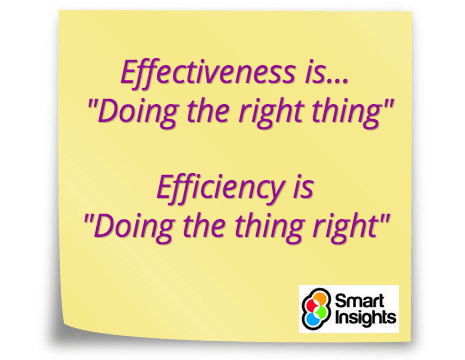Efficiency vs effectiveness definition and explanation
 I think many would think the meaning of efficiency and effectiveness are similar terms for describing the performance of a business process.
I think many would think the meaning of efficiency and effectiveness are similar terms for describing the performance of a business process.
If so, think again, since whatever the type of process you really need both types of measures when identifying the most suitable goals and measures to assess your marketing or business effectiveness. It's fine to say the difference doesn't matter especially, but I think that understanding the difference helps you create a better set of measures!
I hope to show why the difference is important in this article where I'll give a brief definition of each and show examples of efficiency and effectiveness measures applied to digital marketing KPIs.
Definition of efficiency
The simple, often used, definition of efficiency is ("doing the thing right").
We need this measure for marketing activities and business processes since it helps us see when we are minimising resources or time needed to complete a process, i.e. we are keeping our costs low. In digital marketing, for example, efficiency involves increasing conversion rates and reducing costs of acquisition.
Within digital marketing, common efficiency measures across the areas of digital marketing activities of the RACE framework are:
Reach
- Cost of acquisition (CPA)
- Clickthrough rates on Ads or Adwords
Act
- Bounce rate
- Pages per visit
Convert
- Conversion rate to lead or sale
- Checkout conversion rate
Engage
- Repeat conversion rate
- Activity of customers on email lists or followers on social sites
Definition of Effectiveness
The simple definition of effectiveness is ("doing the right thing").
In digital marketing, effectiveness involves supporting broader marketing objectives and often indicates the contribution of the online channel.
Across the digital marketing activities of the RACE framework, examples of effectiveness measures are:
Reach
- Revenue or goal value per visit
- Audience share compared to competitors
- gap analysis of total search demand
Act
- Average order value
- Number of items per order
Convert
- Margin
- Customer satisfaction with site experience
Engage
- Hurdle rate of percentage active online customers, subscribers or followers
- Customer lifetime value
- Customer satisfaction experience across whole site
You can see that sometimes it's not possible to definitively state which is which, but for the main thing is to review that you have a good coverage of each.
See this article for more examples of digital marketing KPIs to track effectiveness of digital marketing.
An example of efficiency and effectiveness measures
I created this example based on the balanced scorecard, popularised in a Harvard Business Review article by Kaplan and Norton (1993).
It is still used in many large organisations and can still be used to today to help translate vision and strategy into objectives and then, through measurement, assessing whether the strategy and its implementation are successful.
| Balanced scorecard sector |
Efficiency |
Effectiveness |
| Financial results (Business value)? |
- Channel costs?
- Channel profitability
|
- Online contribution (direct)
- Online contribution (indirect)?
- Profit contributed
|
| Customer value |
- Online reach (unique visitors as % of potential visitors)
- Cost of acquisition or cost per sale (CPA/CPS)
- Customer propensity
|
- Sales and sales per customer
- New customers
- Online market share
- Customer satisfaction ratings
- Customer loyalty index
|
| Operational processes |
- Conversion rates
- Average order value
- List size and quality
- E-mail active %
|
- Fulfilment times
- Support response times
|
| Operational processes |
- Conversion rates
- Average order value
- List size and quality
- E-mail active %
|
- Fulfilment times
- Support response times
|
The balanced scorecard combines efficiency and effectiveness measures and was a response to over-reliance on financial metrics such as turnover and profitability and the tendency for these measures to be retrospective rather than looking at future potential, as indicated by innovation, customer satisfaction and employee development.
In addition to financial data, the balanced scorecard uses operational measures such as customer satisfaction, efficiency of internal processes and also the organisation's innovation and improvement activities including staff development.
Summary
It is useful to identify efficiency and effectiveness measures separately, since online marketing and web analytics often tend to focus on efficiency. Hasan and Tibbits (2000) note that the internal process measures in particular are concerned with the efficiency and the customer and business value perspectives are indicated with effectiveness, but these measures can be applied across all four areas as we have shown.
References
Hasan, H. and Tibbits, H. (2000) Strategic management of electronic commerce: an adaptation of the balanced scorecard, Internet Research, 10(5), 439, 50.
Kaplan, R.S. and Norton, D.P. (1993) Putting the balanced scorecard to work, Harvard Business Review, September-October, 134, 42.
Create your 90-day plan with the RACE Growth System
Download your free RACE Growth System guide today and unlock our three-step plan of Opportunity, Strategy and Action to grow your business.
Download guide








